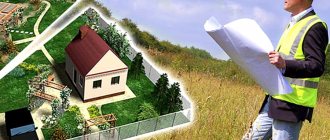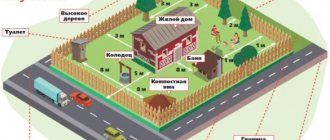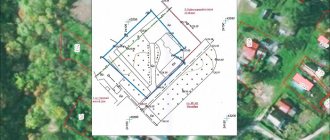The building area is the area occupied by the constructed building. This concept is used in territorial planning.
To determine the building area, the ratio of the total area of the building territory and the area occupied by buildings on the same site is taken.
That is why the building area cannot be identical to the area of the building site, especially taking into account the green areas, paths and car accesses located on it.
What is the built-up area?
The building area is the territory occupied by erected buildings . It is smaller than the total area, since the second concept includes all passages, roads and landscaping areas. It is calculated based on the horizontal projection of the structure on the surface of the foundation.
This term refers to the cross-sectional area of a building in the horizontal plane. The section is made along the base, taking into account all protruding areas.
What is included in the construction area:
- horizontal cross-sectional area of the building's basement;
- porch with ramp;
- terraces and verandas;
- balconies and protruding parts of the roof supported by supporting pillars.
The construction of buildings in the Russian Federation is regulated by building codes and regulations (SNiP) . They also contain a definition of “permitted construction area”. We are talking about the territory that is permitted for development.
For different types of territories, this indicator is calculated individually, but in most cases it does not exceed 30% of the entire site.
The construction area of the warehouse territory is larger than the area of residential buildings. That is why, before starting construction, you must find out how to calculate the building area.
Legal regulation
Modern cities are built according to strict rules related to the requirements of compliance with the possibility of free travel, sanitary standards, and other regulations. Now it is impossible to erect a building whose external boundaries completely coincide with the red land allocation lines. Urban planning regulations determine which part of it can be built on. The Civil Code of the Russian Federation has introduced such a concept as the maximum percentage of development. It is defined as the ratio of the planned parameters of new construction or reconstruction to the entire site. Exceeding the permitted parameters for the built-up area of a residential building will result in refusal to approve the project.
On a note! The exact definition rules can be found in the building regulations (SP), developed for public and residential apartment buildings separately.
Joint ventures are taken as a basis when developing the concept of construction of both individual buildings and residential complexes, and microdistricts. In each case, within one plot of land, only a certain part can be occupied by capital or flat structures: it usually does not exceed 50-60%. The rest of the area will be dedicated to green spaces and recreational areas. Its own rules apply to parking lots: the inclusion of parking in the final formula will depend on their type (aboveground, underground) and purpose (for personal cars or industrial vehicles).
How to determine the building area of a residential building
To carry out the calculations correctly, you should first find out the type of objects being built . According to SNiP, the built-up area of residential buildings must be equal to the horizontal sectional area calculated along the outer perimeter of the house contour. These parameters should include all protruding areas and floors, including architectural parts with supports.
One of the frequently encountered queries when carrying out such calculations is the question of whether the blind area is included in the building area. A blind area is a waterproof covering around a building.
It is included in the area of hard surfaces, and therefore does not apply to the building area. Along with it, the territory of hard surfaces includes roads, sidewalks, sports grounds, parking lots, etc.
It is recommended that you hire a professional to determine the maximum building percentage that is allowed by regulations. They will help you carefully study the site and calculate the most optimal ratio of the areas allocated for the construction of buildings and the general territory.
Experienced professionals will provide a ready-made architectural plan, which indicates the dimensions of the required buildings, and a floor plan.
Construction volume of the building
The construction volume of a building
includes the sum of the volumes of premises and enclosing structures made in the building’s construction system, and is determined relative to the planning level of the ground level:
- construction volume of the above-ground part of the building located above ground level;
- the construction volume of the underground part of the building (if any), located below ground level.
The construction volume of the building is measured with an accuracy of 1 m³ and is calculated:
- for a building with an attic floor (attic), multiplying the horizontal sectional area of the building (along the outline of the external contour of the external walls above the base) by the height of the building;
- for a building without an attic floor by multiplying the vertical cross-sectional area (along the contour of the outer surface of the walls, roof surface, floor surface of the first floor) by the length of the building;
- for rooms with inclined, multi-level, curved surfaces of enclosing structures of walls and ceilings, multiplying the area of their horizontal section along the outer contour of the walls at floor level by the height (or by the average height in case of a curved outline of the ceiling) from the floor to the top (backfill - if there is a structures) of the attic floor;
- for basement and basement premises, multiplying the horizontal sectional area of the building by the height from the floor surface level to the floor surface level of the first floor.
- in total for parts of the building and floors, differing in space-planning and design solutions.
The construction volume of a building includes the volume of light-transmitting facade structures (including glazing of rooms, verandas, skylights), as well as bay windows, transitions between buildings, loggias and niches in external walls. The construction volume of the building does not include construction volumes:
- attached premises, different from the main building in terms of functionality and with enclosing structures made of materials different from the materials of the building’s construction system, balconies and terraces;
- projections of architectural and structural elements, including: canopies (canopies), porticoes, relief architectural details of facades, terminal devices of engineering equipment (pipes, antennas, etc.);
- spaces under the building on supports and arched openings (passages) under the building, interfloor through arched openings, underground channels, ventilated undergrounds of buildings (built on permafrost);
- non-permanent objects (tents, kiosks, canopies, gazebos, platforms), attached and built on.
The length of the building
is determined by the distance between the facade surfaces of the end external walls at the level of the first floor (above the base);
Building height
- determined by the distance from the planning mark of the ground level to the elevation mark to the top of the canopy above the parapet (parapets) of the longitudinal walls of the flat roof, or to the upper edge (ridge, spire) of the surfaces of the mating slopes of the roof covering of the pitched roof. The fire safety height of the building is determined by the distance:
- between the mark of the passage surface for fire engines and the lower boundary of the opening opening (window) in the outer wall of the upper floor (including the attic or mezzanine, not taking into account the non-residential attic space);
- or half the sum of the floor and ceiling marks of the upper floor premises with non-opening windows (openings);
- or to the upper boundary of the roof fence in use.
Floor height
is the distance from the top of the underlying floor (or ground floor) to the top of the floor above it (or to the bottom of the rafters for a one-story building).
Room height
- the distance from the top of the underlying floor (or ground floor) to the bottom of the floor above it (or to the bottom of the rafter structures for a one-story building).
What is the difference between the built-up area and the total area
The total area differs from the building area in scale . The total area includes the parameters of all rooms and areas of the site. To calculate the total area of a residential building, the values of all premises in the building are summed up.
The space of apartment buildings is divided into useful and residential . The construction area of the residential part includes all living quarters in the house with a ceiling height of 2.2 m. Such rooms are intended for living. And usable area includes territory not intended for living.
We are talking about auxiliary premises located inside the house. These areas include:
- verandas;
- loggias;
- built-in cabinets;
- storerooms;
- vestibules.
The size of the residential premises is calculated after finishing work is completed . It includes the floor area excluding the baseboard. If the room has a fireplace or stove, they are also not taken into account when calculating the area.
To calculate the area of a terrace or balcony, only internal parameters without fences are taken. To calculate the total area of a residential building, the areas of residential and auxiliary areas are added up.
Calculation of the building area of multi-storey buildings
When calculating the building area of a building, its number of floors is also important . In this case, only above-ground floors with ceilings higher than 2 m are taken into account.
These can be attic and technical floors, if the height of their ceilings complies with the standard. Interfloor areas and underground areas with ceilings at a level of 1.8 m do not apply to above-ground floors.
If a building consists of several parts of different floors or is built on a site with a slope that led to the addition of additional floors, then all parts of the house are counted separately.
To calculate the building area of multi-storey buildings, reduction factors are used:
- 0.3 – for balconies and terraces;
- 0.5 – for loggias.
Also, the calculation features are also typical for multi-level apartments, since they have internal stairs between floors. The footage of the staircase is taken into account only if the height of its flight is 1.6 m or more.
To calculate the built-up area of a multi-story building, measurements from each floor are added up. Measurements of loggias, balconies and staircases in the house are also taken into account.
What is included in the concept
The building area is defined as the size of the land plot onto which the horizontal parameters of the object are projected. If you mentally cut a building horizontally into two parts, then the boundaries of the resulting section will be the answer to the question. However, not all elements of the object will be taken into account in the calculation, but only those that rest on the foundation plane. The following rules apply:
- porch, veranda, gallery standing on a common concrete or stone foundation are taken into account in the calculation;
- balconies or parts of the roof, if they extend beyond the boundaries of the foundation, are not taken into account;
- an underground parking lot, if its outline intersects the outer boundaries of the walls, will be included in the general calculation.
Since in the area under construction, in addition to the residential building or public building itself, there may be other structures, you should know that they will also be taken into account, but not in all cases. The difference is related to their intended purpose.
Important! Parking lots for industrial and technical vehicles, technological structures, boiler rooms, basements over which there are no buildings, but they cannot be built for technological reasons, bomb shelters will also be taken into account. Children's playgrounds, lawns, and open parking spaces for citizens are not taken into account.
Other significant parameters
Builders are also interested in the answer to the question of how to calculate the total area of a building. In this case, the dimensions of each floor, attic, basement, balconies and loggias will be taken into account. A similar parameter is also stated in the project submitted for permission. When preparing the documentation, you need to keep in mind that the technical underground will not be included in the calculation if the height of its ceilings is less than 1.8 m. For each land allotment, the urban planning documentation establishes coefficients to which both the building area and the total area must correspond. Within their limits, you can vary the number of storeys, the number of protruding elements or other buildings located nearby, within the boundaries of the built-up area.
Normative base
If you decide to independently calculate the building area, then first of all you should familiarize yourself with the current legislative rules and regulations.
In 2021, all requirements for such calculations can be found in SNiP . These standards describe in detail the characteristics of residential buildings and the list of applications necessary for the design and construction of houses.
SNiP also specifies methods for measuring the area of residential and auxiliary premises, taking into account walls, ceilings and other partitions. To determine the dimensions, measurements are taken along the internal lines of the room.
You have JavaScript disabled.
1. As an analysis of legislative and other regulations and normative documents at the federal level shows, there is no normative definition of the concept of “development area”.
However, rules for calculating the building area for capital construction projects for various purposes have been established.
Such rules apply to residential, public and industrial buildings, as well as to industrial enterprises.
So,
a) in accordance with paragraph B.1.5 of Appendix B SP 54.13330.2011 “SNiP 31-01-2003. Residential multi-apartment buildings" (approved by order of the Ministry of Regional Development of Russia dated December 24, 2010 No. 778) "The building area of a building is determined as the horizontal sectional area along the external contour of the building at the base level, including protruding parts, including porches and terraces. The area under the building located on supports, as well as the passages under it, are included in the building area”;
b) clause D.7 of Appendix G SP 118.13330.2012 “SNiP 31-06-2009. Public buildings and structures" (approved by order of the Ministry of Regional Development of Russia dated December 29, 2011 No. 635/10) established: "D.7 The building area is determined as the horizontal sectional area along the external contour of the building along the base, including protruding parts (entrance platforms and steps , verandas, terraces, pits, basement entrances). The building area also includes the underground part that extends beyond the outline of the building projection.
Additionally, the construction area of the underground parking lot, which extends beyond the outline of the building projection, is indicated;
c) in paragraph 4.11 SP 56.13330.2011 “SNiP 31-03-2001. Industrial buildings" (approved by order of the Ministry of Regional Development of Russia dated December 30, 2010 No. 850) states: "The building area is determined along the external perimeter of the building at the base level, including protruding parts, passages under the building, parts of the building without external enclosing structures";
d) paragraph 2 of the notes to the table in Appendix B of SP 18.13330.2011 “SNiP II-89-80*. Master plans for industrial enterprises" (approved by order of the Ministry of Regional Development of Russia dated December 27, 2010 No. 790) established:
“The development area is defined as the sum of the areas occupied by buildings and structures of all types, including sheds, open technological, sanitary, energy and other installations, overpasses and galleries, areas for loading unloading devices, underground structures (reservoirs, cellars, shelters, tunnels, above which cannot accommodate buildings and structures), as well as open parking lots for cars, machines, machinery and open warehouses for various purposes, provided that the dimensions and equipment of parking lots and warehouses are accepted according to the standards of technological design of enterprises.
The construction area should include reserve areas on the site territory, designated in accordance with the design assignment for the placement of buildings and structures on them (within the dimensions of the specified buildings and structures).
The construction area does not include areas occupied by blind areas around buildings and structures, sidewalks, roads and railways, railway stations, temporary buildings and structures, outdoor sports fields, areas for workers' recreation, green spaces (trees, shrubs, flowers and grasses) , open parking lots of vehicles belonging to citizens, open drainage and other ditches, retaining walls, underground buildings and structures or parts of them, above which other buildings and structures may be located.”
2. Since the sets of rules listed in subparagraph 1 of paragraph 25 of this Collection are included in the List of national standards and sets of rules (parts of such standards and sets of rules), as a result of which, on a mandatory basis, compliance with the requirements of the Federal Law “Technical Regulations on the Safety of Buildings and Structures” is ensured ", approved. By Decree of the Government of the Russian Federation dated December 26, 2014 No. 1521, the determination of the building area of a capital construction project must comply with the rules specified in paragraph 1 of this answer.
3. At the planning stage of investment activities for the creation of a capital construction project, the cost of construction can be determined by enlarged estimate standards, which are calculated in accordance with the Methodological Guidelines for the development of enlarged estimate standards for non-production facilities and engineering infrastructure, approved. by order of the Ministry of Regional Development of Russia dated November 16, 2010 No. 497 (Registered with the Ministry of Justice of Russia on January 21, 2011, registration No. 19554).
At the stage of preparing project documentation and developing working documentation, the cost of construction is determined in accordance with the requirements of clauses 3.15 ÷ 3.18, 3.23 MDS 81-35.2004 “Methodology for determining the cost of construction products on the territory of the Russian Federation”, approved. by resolution of the State Construction Committee of Russia dated 03/05/2004 No. 15/1 (According to the letter of the Ministry of Justice of Russia dated 03/10/2004 No. 07/2699-UD, these MDS 81-35.2004 do not require state registration) according to working drawings and site and local estimates attached to them for the construction of the facility.
The cost of constructing a capital construction project cannot be determined based on the cost per square meter of built-up area.








